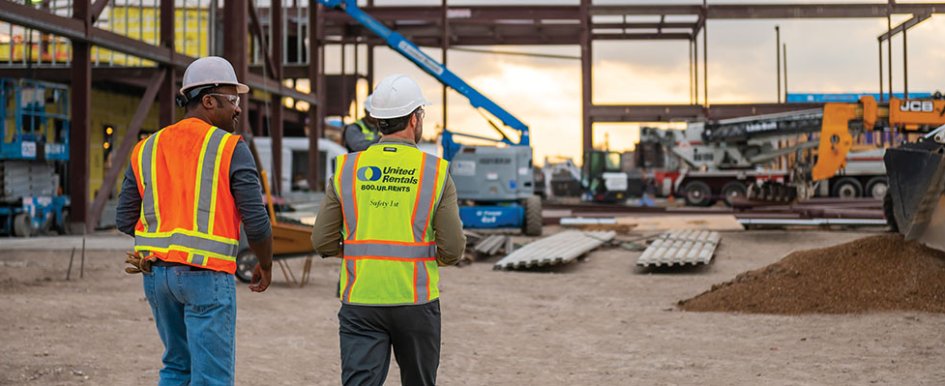
Construction equipment typically makes up a small percentage of a project budget, but it plays a large role in the environmental impacts of day-to-day operations. How equipment is powered and whether it’s purchased or rented affects the fuel consumed, the greenhouse gas emissions produced and the amount of natural resources used.
If you’re a midsized general contractor, you have several reasons to choose renting over owning. It lets you avoid a capital expenditure, eases the burden of performing maintenance and repairs, and has the potential to shrink overall fleet costs depending on utilization and operating expenses. But there’s yet another potential benefit of renting: It can increase your company’s sustainability without compromising productivity.
Below are six reasons renting is often the more sustainable choice compared to owning.
1. Newer equipment may be more fuel efficient.
It’s not uncommon for construction business owners to keep some construction equipment for as long as 10 years. Older equipment can continue to perform well if it’s been operated properly and well maintained, but worn-out equipment may run less efficiently than newer equipment, requiring more fuel and producing more carbon emissions.
When you rent equipment from a respected temporary equipment vendor, you’re typically getting relatively new machines. Newer machines may run more efficiently simply because they operate closer to peak performance; in addition, they tend to have updated designs that make them more fuel efficient.
2. Renting is a low-stakes way to test alternatively powered equipment.
Most equipment on jobsites today — including mobile power generators — runs on diesel. While Tier 4 Final diesel engines run cleaner than older diesel engines, diesel still produces 10% to 20% more carbon emissions of propane, for example. Electric equipment, meanwhile, produces zero emissions at the source.
Renting affords you the opportunity to try alternatively powered equipment you may not be ready to purchase, such as solar-powered light towers and electric machines. Electric machines currently on the rental market include forklifts, aerial lifts, skid steers and mini excavators, and those offerings continue to expand.
Electric construction equipment has come a long way in recent years thanks to advances in battery technology. The performance is now on par with that of fuel-powered counterparts. Renting provides the chance to assess its role on projects, test run times, and experiment with charging methods and schedules.
Deciding which electric equipment to pilot can be challenging. One smart approach is to begin by identifying the equipment in your existing fleet that generates the most carbon emissions. Software tools available from some rental providers as part of their fleet management platform automatically calculate the estimated emissions of equipment based on engine hours and
fuel type.
3. Equipment maintenance is built in.
Routine service and preventive maintenance are crucial for keeping equipment running as cleanly and efficiently as possible. Machines that are well maintained also last longer, which maximizes the resources and materials used to make them.
Implementing and overseeing an effective preventive maintenance program is challenging and time-consuming, especially when equipment is moving from jobsite to jobsite.
Renting removes the maintenance burden from construction business owners, whose core competencies lie elsewhere. Top-tier rental providers maintain their equipment in accordance with the original equipment manufacturer’s requirements, regardless of its age, so it remains in top operating condition.
4. The sharing economy increases equipment utilization.
Equipment underutilization is common on jobsites and in privately owned fleets. Reducing underutilization can boost a company’s return on investment; it also increases the sustainability of construction operations. The more equipment is used, the fewer pieces of new equipment manufacturers need to produce.
Renting allows you to keep and pay for only the equipment that is actively needed. As a result, fewer pieces of machinery sit idle on the jobsite or in the yard. If a project no longer requires the number of forklifts, boom lifts or backhoes on site, returning some or all of them is as easy as making a phone call or tapping a few buttons on the vendor’s mobile app. Selling underutilized owned equipment, on the other hand, is a larger undertaking.
5. Renting makes it easier to track.
Often, companies don’t realize when equipment is being underutilized. Some rental equipment providers outfit their machines with telematics devices that transmit the location of the equipment in real time so it’s not “lost” on the jobsite or hoarded. By leveraging a cloud-based fleet management system, you can not only see every piece of telematics-enabled equipment on the jobsite, but you can also see when it was last used.
A fleet management system that allows users to run utilization reports helps managers understand whether a project is over- or under-fleeted, and which pieces of equipment or equipment category classes are no longer needed.
6. Renting may reduce highway miles.
Equipment must be transported from jobsite to jobsite by truck or trailer. Those road miles contribute to a company’s carbon footprint. Renting equipment for each new project can potentially reduce the total miles driven.
Best-in-class rental companies use logistics and route optimization tools for delivering and picking up equipment. Equipment is loaded to fully utilize trailer deck space and maximize the number of deliveries and pickups per trip. Delivery trucks are kept within concentrated geographic areas and on preferred roads. These strategies reduce the number of empty loads and the number of miles driven so trucks consume less fuel and generate fewer carbon emissions.
Renting and owning both have their advantages. While the largest general contractors often rent all the equipment necessary for megaprojects, many midsized companies are best served by a combination of rented and owned equipment. Leaning more heavily on renting is a practical, cost-effective way to lighten your environmental footprint and increase efficiency at your jobsite.

